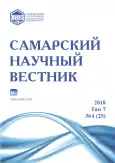Main weed species of the Republic of Bashkortostan: position on environmental gradients and agrobiological groups
- Authors: Khasanova G.R.1, Yamalov S.M.2, Lebedeva M.V.2
-
Affiliations:
- Bashkir State Agrarian University
- South-Ural Botanical Garden-Institute of the Ufa Federal Research Centre of Russian Academy of Sciences
- Issue: Vol 7, No 4 (2018)
- Pages: 134-138
- Section: 03.02.00 – General Biology
- URL: https://journals.rcsi.science/2309-4370/article/view/21865
- DOI: https://doi.org/10.17816/snv201874123
- ID: 21865
Cite item
Full Text
Abstract
The paper presents a study of the main weed species in the Republic of Bashkortostan according to the results of a floristic analysis of 1170 geobotanical releves. The authors define 30 species, their constancy is more than 20%. Five species of dicotyledonous and 1 species of monocotyledonous plants Convolvulus arvensis, Chenopodium album, Cirsium setosum, Fallopia convolvulus, Avena fatua, Sonchus arvensis are characterized with the greatest values of occurrence (higher than 50%). According to the results of the ordination analysis and ANOVA the considered species are well differentiated on the gradients of the factors of moistening, richness of the soil and a crop. Among agrobiological groups of weed species the annual and creeping-rooted weeds prevail.
Full Text
##article.viewOnOriginalSite##About the authors
Gulnaz Rimovna Khasanova
Bashkir State Agrarian University
Email: gulnazrim@yandex.ru
candidate of biological sciences, associate professor of Soil Science, Botany and Selection Department
Russian Federation, UfaSergey Maratovich Yamalov
South-Ural Botanical Garden-Institute of the Ufa Federal Research Centre of Russian Academy of Sciences
Email: yamalovsm@mail.ru
doctor of biological sciences, leading researcher of Wild-Growing Flora and Herbasceous Plants Introduction Laboratory
Russian Federation, UfaMaria Vladimirovna Lebedeva
South-Ural Botanical Garden-Institute of the Ufa Federal Research Centre of Russian Academy of Sciences
Author for correspondence.
Email: lebedevamv@mail.ru
candidate of biological sciences, senior researcher of Tropical and Subtropical Plants Group
Russian Federation, UfaReferences
- Миркин Б.М., Наумова Л.Г. Современное состояние основных концепций науки о растительности. Уфа, 2012. 488 с.
- Kukorelli G., Reisinger P., Pinke G. ACCase inhibitor herbicides - selectivity,weed resistance and fitness cost: a review // International Journal of Pest Management. 2013. Vol. 59, № 3. P. 165-173. doi: 10.1080/09670874.2013.821212.
- Begum M., Juraimi A.S., Azmi M., Kajan A., Syed Omar S.R. Weed Vegetation of Direct Seeded Ricefields in Muda Rice Granary Areas of Peninsular Malaysia // Pakistan journal of Biological Science. 2005. Vol. 8 (4). P. 537-541. doi: 10.3923/pjbs.2005.537.541.
- Kamal-Uddin M., Juraimi A.S., Begum M., Ismail M.R., Rahim A.A., Othman R. Floristic composition of weed community in turf grass area of west peninsular Malaysia // International Journal of Agriculture and Biology. 2009. Vol. 11. P. 13-20.
- Nowak S., Nowak M., Nobis A. Nobis Crop type and altitude are the main drivers of species composition of arable weed vegetation in Tajikistan // Weed Research. 2015. doi: 10.1111/wre.12165.
- Lososová Z., Chytrý M., Cimalová S., Kropáč Z., Otýpková Z., Pyšek P., Tichý L. Weed vegetation of arable land in Central Europe: Gradients of diversity and species composition // Journal of Vegetation Science. 2004. № 15. P. 415-422. doi: 10.1111/j.1654-1103. 2004.tb02279.x.
- Pinke G., Pál R., Tóth K., Karácsony P., Czúcz B., Botta-Dukát Z. Weed vegetation of poppy (Papaver somniferum) fields in Hungary: effects of management and environmental factors on species composition // Weed Research. 2011. Vol. 51 (6). P. 621-630. doi: 10.1111/j.1365-3180.2011.00885.x.
- de Mol F., Redwitz C., Gerowitt B. Weed species composition of maize fields in Germany is influenced by site and crop sequence // Weed Research. 2015. Vol. 55 (6). P. 574-585.
- Nowak S., Nowak А., Nobis M., Nobis A. Weed vegetation of cereal crops in Tajikistan (Pamir Alai Mts., Middle Asia) // Phytocoenologia. 2013. Vol. 43 (3-4). Р. 225-253. doi: 10.1127/0340-269X/2013/0043-0557.
- Nowak A., Nobis M., Nowak S., Nobis A., Swacha G., Kącki Z. Vegetation of Middle Asia - the project state of art after ten years of survey and future perspectives // Phytocoenologia. 2017. Vol. 47 (4). Р. 395-400. doi: 10.1127/phyto/2017/0208.
- Дмитриев Г.О. Главные сорняки Башкирии и борьба с ними. Уфа, 1937. 58 с.
- Миркин Б.М., Абрамова Л.М., Ишбирдин А.Р., Рудаков К.М., Хазиев Ф.X. Сегетальные сообщества Башкирии. Уфа, 1985. 155 с.
- Абрамова Л.М. Сегетальная растительность Башкирского Предуралья: автореф. дис. … канд. биол. наук. Тарту, 1987. 16 с.
- Хасанова Г.Р., Ямалов С.М., Корчев В.В. Динамика адвентивного компонента ценофлор сегетальных сообществ на Южном Урале // Известия Самарского научного центра РАН. 2014. Т. 16, № 1-3. С. 838-840.
- Хасанова Г.Р., Ямалов С.М., Корчев В.В. Флористический состав сегетальных сообществ Южного Урала // Вестник Башкирского государственного аграрного университета. Уфа. 2014. № 2 (30). С. 38-41.
- Хасанова Г.Р., Лебедева М.В., Миркин Б.М., Наумова Л.Г. Последствия изменения сельскохозяйственных технологий для распределения сегетальных растительных сообществ и видов в Республике Башкортостан // Экология. 2017. № 5. С. 396-399.
- Малышев Л.И. Флористическое районирование на основе количественных признаков // Ботан. журн. 1973. Т. 58, № 11. С. 1581-1602.
- Фисюнов А.В. Сорные растения. М., 1984. 320 с.
- Ter Braak C.J.F., Šmilauer P. Reference manual and CanoDraw for Windows User’s guide: Software for Canonical Commuhity Ordination (version 4.5). Microcomputer Power. Ithaca, NY, USA, 2002. 500 p.
- Королюк А.Ю. Экологические оптимумы растений юга Сибири // Ботанические исследования Сибири и Казахстана. 2006. Вып. 12. С. 3-38.
- Плохинский Н.А. Биометрия. М., 1970. 367 с.
- Лунева Н.Н., Филиппова Е.В. Постоянство присутствия видов сорных растений в посевах сельскохозяйственных культур в Ленинградской области // Сорные растения в изменяющемся мире: актуальные вопросы изучения разнообразия, происхождения, эволюции: первая междунар. науч. конф. Санкт-Петербург, 6-8 декабря 2011 г. СПб.: ВИР, 2011. С. 209-215.
Supplementary files







